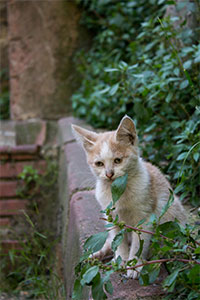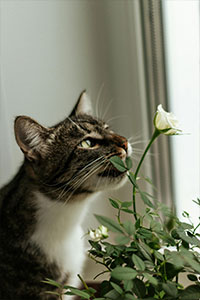Jessica W. Kelvin - Mar.05.2024
Why Do Cats Eat Grass?
7 Insights into Feline Behavior

Can Cats Eat Chocolate?
MMost people know that dogs shouldn’t, but can cats eat chocolate? As picky eaters, cats are far less likely than dogs to seek out your chocolate stash, but some will find their way into a chocolaty treat or may even be fed one by an unwitting pet parent. The short answer is no, cats should never eat chocolate. But why not? And what happens if they do?
The intoxicating nature of chocolate
Chocolate contains the chemical compounds caffeine and theobromine, which are part of the methylxanthine chemical group. These particular compounds are not harmful to humans, but can cause significant medical problems for your feline friends. Theobromine affects your cat in four different ways:
1, Acts as a stimulant, which increases heart rate
2, Acts as a diuretic, causing increased loss of body fluids
3, Causes gastrointestinal upset
4, Upsets the nervous system
While the concentration of theobromine in chocolate is 3–10 times that of caffeine, they both play a role in upsetting your pet’s equilibrium and causing potentially fatal abnormalities.
What type of chocolate is the most toxic?
Any chocolate can be harmful to cats. Caffeine and theobromine are in all types of chocolate, but at different concentrations. Baking chocolate, semisweet chocolate, and dark chocolate are the most toxic because they have higher concentrations of methylxanthines than milk or white chocolate.
Depending on the type of chocolate and the amount consumed, reactions can range from mild to life-threatening. That goes for all chocolate food variations, including cocoa powder, chocolate candy, chocolate cake, chocolate pudding, cacao beans, and more. There are formulas to calculate how much chocolate is concerning based on what type it is. An easy-to-remember takeaway as a baseline is that 1 ounce of milk chocolate per pound of body weight is a potentially lethal dose in dogs. Now imagine that in a cat: it doesn’t always have to be a lot to be a big problem. View the VetMeds.org table below for specific amounts of theobromine toxic consumption based on a cat’s weight.
Symptoms of chocolate toxicity
When a cat ingests chocolate or a chocolate byproduct, the first physiological response is unnatural stimulation of the heart and nervous system. The darker the chocolate and the more consumed, the more intense the symptoms can become:
-Vomiting
-Diarrhea
-Increased body temperature
-Increased reflex responses
-Muscle rigidity
-Rapid breathing
-Increased heart rate
-Low blood pressure
-Seizures
-Advanced signs (cardiac failure, weakness, and coma)
Cats:Theobromine Toxic Consumption
Most Cats: 1-10 lbs(0.45-4.6 kg), Large Cats11-25 lbs(5-11.4 kg)
Cacao Beans: Most Cats> 0.05 oz, Large Cats> 0.5 0z
Unsweetened Baking Chocolate: Most Cats> 0.2 oz, Large Cats>2 0z
Dark Chocolate: Most Cats> 0.5 0z, Large Cats>7 oz
Milk Chocolate: Most Cats>1.5 0z, Large Cats>16.5 0Z
White Chocolate: Most Cats>360 oz, Large Cats>4000 0z
Cocoa Powder: Most Cats> 01 0z, Large Cats>10z
Cocoa Bean Mulch: Most Cats>0.1 0z, Large Cats>1 0z

Showing making procedure is a good way to guarantee product quality
Stress Relief
Eating grass can also serve as a form of stress relief for cats, providing a calming activity that distracts from anxiety or boredom.


Get customer attention by clean visual and video
Instinctual Actions
Grass eating is an instinctual behavior that may stem from a cat's need to seek out alternative food sources or to induce vomiting to clear their stomachs of indigestible materials.
Act quickly
If you think your cat has eaten chocolate, don't wait to see if symptoms develop. Try to determine how much they have eaten and call your veterinarian for advice. To understand the level of toxicity your cat might experience, the vet's office will likely want to know the following:
-how much your cat weighs
-how much chocolate you suspect they ate
-the name of the specific product ingested (if possible)
-when the ingestion occurred
-any clinical symptoms you’ve noticed
The vet will most likely want to induce vomiting right away to minimize the digestion of the methylxanthines and reduce the overall risk of severe poisoning. But keep in mind that you cannot safely induce vomiting in cats at home. You will need to go to your vet or the nearest animal hospital.
In many cases, small quantities are not likely to be a problem, but larger quantities may require you to rush your cat to the veterinarian. If your veterinarian is unavailable or unequipped to handle the situation, call the nearest animal hospital or the ASPCA Animal Poison Control Center (888-426-4435). This is especially important if your cat is displaying more severe symptoms, such as muscle tremors or repeated vomiting.
While waiting for your cat to be evaluated, try to keep them cool, calm, and in a quiet place to prevent the escalation of any symptoms. The veterinarian will conduct a thorough physical examination, involving a chemical blood profile, electrolyte panel, and urinalysis to discern whether or not your cat has experienced a caffeine or theobromine overdose. Electrocardiography may also be employed to observe any possible irregularities in your cat's heartbeat.
After an incident of chocolate poisoning, continue to keep your cat in a quiet and cool environment. With a mild, bland diet over the following two or three days, including plenty of hydrating fluids, your cat should be just fine.
Article credit: Heidi Cohen (https://heidicohen.com/use-blog-to-sell/)
Digestive Aid
Grass acts as a natural laxative, helping cats pass hairballs or other indigestible items through their digestive tract more easily.
Elimination of Parasites
It's also theorized that grass eating may help cats eliminate intestinal parasites, although this benefit is more anecdotal than scientifically proven.
Prevention
Unfortunately, food poisoning from things like chocolate happens far too frequently in cats. Now you know how grave the consequences can be, so be mindful about your chocolate stash. Keep chocolaty foods and treats guarded in firmly closed containers and cabinets, be wary of feeding your cat anything that might contain chocolate, and take a moment to educate house guests and friends who might interact with your cat about chocolate toxicity. If you're lamenting the loss of your candy dish, keep your cat safe and put a lid on it.
How to Safely Introduce Grass to Your Cat
Suitable Types of Grass
Certain types of grass are more beneficial and safer for cats, including wheatgrass, which is often sold as "cat grass."
Growing Your Own Cat
Grass
For the safety and health of your cat, consider growing your own cat grass at home. It's a simple and effective way to ensure they're getting a safe product.
Alternative Behaviors and Solutions
Dietary Supplements
If your cat shows an excessive interest in eating grass, it might indicate a dietary deficiency. Consult with a veterinarian about supplementing your cat's diet.
Behavioral Enrichment
Providing toys, climbing structures, and engaging activities can reduce your cat's inclination to eat grass by offering alternative forms of stimulation.
Why Do Cats Eat Grass?
Exploring the curiosity behind this behavior reveals a complex blend of nutritional, psychological, and instinctual factors. Understanding these can help cat owners provide better care and enrichment for their feline friends.
Owner Experiences and Advice
Personal Anecdotes
Many cat owners have observed their pets eating grass and have noted the benefits or concerns that came with it. Sharing these experiences can offer valuable insights for other pet owners.
Expert Recommendations
Veterinarians and animal behaviorists can provide professional advice on managing grass-eating behavior, ensuring it remains a safe and positive experience for your cat.
FAQs
Cats should not eat chocolate ice cream; not only is chocolate toxic to cats, but ice cream often contains toxic ingredient propylene glycol. Ingesting propylene glycol can lead to anemia in cats.
Say it at the end
Understanding why cats eat grass sheds light on their complex behaviors and the natural instincts that drive them. By providing safe, suitable grass and paying attention to the underlying reasons for this behavior, cat owners can ensure their feline companions lead happy, healthy lives.












